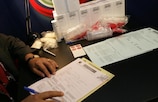WADA 2017 list, UEFA sample storage
Sunday, January 1, 2017
Article summary
The 2017 World Anti-Doping Agency (WADA) Prohibited List is now in force, and UEFA has decided to introduce long-term sample storage.
Article top media content

Article body
The World Anti-Doping Agency has issued a new list of prohibited substances and methods, which has come into effect on 1 January 2017.
The Prohibited List – which can be found in the supporting documentation on the right of the page – specifies substances and methods prohibited in sport. Implementation of the list is mandatory for organisations that have adopted the World Anti-Doping Code. It applies to all UEFA competitions.
The 2017 list contains several changes compared to the 2016 list. The document summary of modifications, also available on the right of the page, lists them all, but the main ones are as follows:
Substances and methods prohibited at all times (in- and out-of-competition)
S1: Anabolic agents
• 5α-androst-2-ene-17-one, commonly known as "Delta-2" or 2-androstenone, was added as an example of a metabolite of DHEA. It has recently been found in dietary supplements.
S2: Peptide hormones, growth factors, related substances and mimetics
• To extend the scope of Erythropoietic Stimulating Agents, GATA inhibitors (e.g. K-11706) and Transforming Growth Factor-β (TGF-β) inhibitors (e.g. sotatercept, luspatercept) were added;
• Molidustat was added as another example of HIF stabilizer;
• Cobalt: it is reiterated that vitamin B12, which contains cobalt, is not prohibited.
S3: Beta-2 Agonists
• Examples of selective and non-selective beta-2-agonists were added (fenoterol, formoterol, higenamine, indacaterol, olodaterol, procaterol, reproterol, salbutamol, salmeterol, terbutaline, vilanterol);
• Higenamine is documented to be a constituent of the plant Tinospora crispa, which can be found in some dietary supplements and is considered by WADA to be a non-selective beta-2-agonist;
• Dosing parameters of salbutamol were refined to make it clear that the full 24 hour dose should not be administered at one time;
• The maximum dosage for salmeterol was stated according to the manufacturers' recommendations.
S4: Hormone and metabolic modulators
• Androsta-3,5-diene-7,17-dione (arimistane) was added as a new example of aromatase inhibitor.
Prohibited Methods
M1: Manipulation of blood and blood components
• Supplemental oxygen administered by inhalation, but not intravenously, is permitted. To clarify this, M1.2 now reads "excluding supplemental oxygen by inhalation".
Substances and methods prohibited in-competition
S6: Stimulants
• Lisdexamfetamine was added to S6.a; it is an inactive pro-drug of amphetamine;
• In the absence of an INN for methylhexaneamine, its International Union of Pure and Applied Chemistry (IUPAC) name, 4-methylhexan-2-amine, was added. A number of other synonyms exist for methylhexaneamine including: 1,3-dimethylamylamine, dimethylpentylamine; methylhexamine; methylhexanamine; 1,3-dimethylpentylamine;
• Regular food consumption will not yield sufficient levels of phenylethylamine to result in an Adverse Analytical Finding.
S7: Narcotics
• Nicomorphine was added. It is an opioid analgesic drug, which is converted to morphine following administration.
Long-term sample storage
At its meeting on 9 December 2016, the UEFA Executive Committee approved that all doping control samples collected in the UEFA Champions League, UEFA Europa League, UEFA European Football Championship and UEFA Super Cup should be stored for up to ten years in order to allow re-testing at any time, in particular when a new detection method becomes available.
This long-term sample storage allows anti-doping rule violations to be prosecuted up to ten years after they have been committed. If a new analysis on stored samples proves an anti-doping rule violation, then the player concerned will be suspended according to the Anti-Doping Regulations in force at the time of the sample collection.
In addition to facing a suspension, players may also have additional disciplinary sanctions imposed on them, such as losing medals or being fined. If more than two players from the same team are found to have committed an anti-doping rule violation during a competition period, the team may receive a sanction, such as the loss of titles or being disqualified from current or future competitions. Article 6 of the Disciplinary Regulations provides the full list of possible disciplinary measures.
As such, the storage and retesting of samples provide a significant deterrent effect. As an example, the International Olympic Committee announced in early December that their reanalysis of the samples from Beijing 2008 and London 2012 had led to 101 new adverse analytical findings.
National associations, clubs, team doctors and players should all take note of this important decision, which has potentially serious consequences for players and teams.






